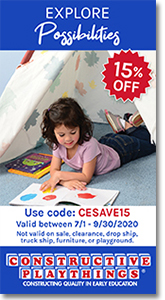ExchangeEveryDay Past Issues
 << Previous Issue
| View Past Issues | | Next Issue >>
<< Previous Issue
| View Past Issues | | Next Issue >> -Loris Malaguzzi, Founder of the Reggio Emilia approach
In the article, “Turn Children Loose Outside!,” which forms the basis for the newest Exchange Reflections “Learning Outdoors with Natural Loose Parts,” author Elizabeth Richards writes:
“The theory of loose parts has been around for decades, coined by landscape architect Simon Nicholson. In an article first published in Landscape Architecture in October 1971, he wrote, ‘The theory of loose parts says, quite simply, the following: In any environment, both the degree of inventiveness and creativity, and the possibility of discovery, are directly proportional to the number and kind of variables in it.’ Nicholson felt that the world was very restrictive for children, prohibiting them from playing with anything that might satisfy their curiosity and sense of discovery. Nicholson thought there was a better way: allowing children to mess around with loose parts in their play. Simply put, the theory encourages providing children with ample space and a variety of materials that can be moved, manipulated, changed and experimented with in any manner they see fit…
Administrators and teachers are recognizing just how much learning happens when children are given the space to be their most creative selves. More and more often, I see loose parts deliberately placed in classrooms I visit, and intentionally incorporated into teachers’ planning. This is less true in the outdoor spaces that programs use, but I believe it is time to embrace loose parts play outside, as well. The benefits gained from loose parts play, combined with the benefits of prolonged outdoor experiences, can help us nurture the natural creativity and thirst for discovery that young children possess.”
 |





Post a Comment